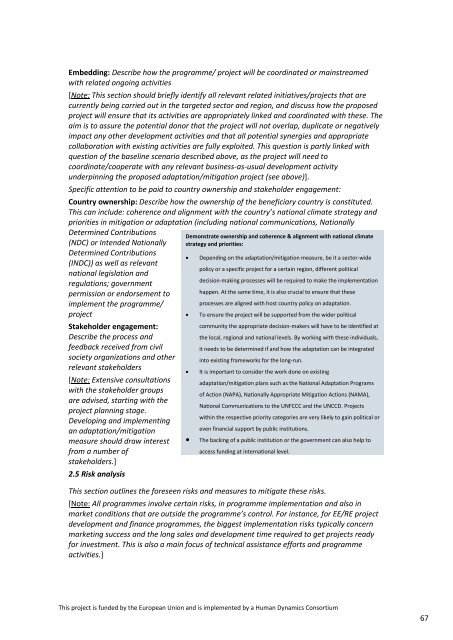311017_CESMED Funding_Mechanisms_Final
Create successful ePaper yourself
Turn your PDF publications into a flip-book with our unique Google optimized e-Paper software.
Climate impact potential: Specify the expected mitigation/adaptation impacts, such as total<br />
tonnes of CO2eq avoided or reduced per annum, total number of direct and indirect<br />
beneficiaries, number of beneficiaries relative to total population. For mitigation, specific<br />
attention to be paid to: baseline emissions, expected avoided emissions. For adaptation,<br />
specific attention to be paid to: ecological and socio-economic context of the programme/<br />
project and its perspectives to climate change, forms of vulnerability and existing resilience<br />
capacity, which vulnerabilities will the programme/ project limit.<br />
[Note: This section should give a concise description of each of the specific<br />
adaptation/mitigation activities/investments that the project would implement, how they<br />
build on to existing development activities (i.e. the baseline activities identified above), how<br />
they will be implemented in practice, and what impacts they are expected to have in terms of<br />
reducing the climate change vulnerabilities or improving the GHG emissions profile described<br />
above. This section should demonstrate to the donor how the project will lead to concrete<br />
and measurable impacts in the targeted sector and/or region. The discussion can take its<br />
starting point in the differentiation between ‘investment activities’ and ‘capacity building<br />
activities’.]<br />
Catalysing impact potential: Specify the potential for scaling-up and replication, knowledge<br />
and learning, contribution to enabling environment and regulatory or policy framework<br />
[Note: For instance, many programmes seek to demonstrate successful financing<br />
mechanisms and business models, engage commercial parties and then promote a<br />
commercially self-sustaining market dynamic, so that market actors will continue to develop,<br />
implement and finance energy efficiency/renewable energy projects after the programme is<br />
completed. This is an attractive strategy for funders. The plan of the programme to achieve<br />
this result should be discussed, along with strategies for replication. A budget for replication<br />
could constitute a second phase of a programme.]<br />
Sustainable development potential: Specify the expected economic, social and<br />
environmental co-benefits (impacts on job creation, technology transfer, economic activities,<br />
increased resilience, improved nutrition, etc.)<br />
Sustainability of impacts: Specify how the programme/ project activities will continue after<br />
its completion, e.g. whether and how market actors will continue to develop, implement and<br />
finance activities<br />
[Note: This section should demonstrate to the funder how the project interventions have<br />
been designed in a way that insures that adaptation/mitigation benefits are sustained<br />
beyond the lifetime of the funder’s involvement. This discussion could include elements both<br />
of financial, social and environmental sustainability as relevant.]<br />
2.4 Implementation and management plan<br />
This section outlines the implementation and management plan for the programme/ project.<br />
Implementing entity: Describe who will implement the programme/ project and their<br />
comparative advantage(s) compared to other potential implementing entities. Describe their<br />
experience and credibility. Describe the project management/ organisational structure:<br />
specify the specific roles and responsibilities of each of the implementing entities, their level<br />
of involvement in the project design and implementation, and underlying contractual<br />
arrangements. Describe who will take care of the monitoring process.<br />
[Note: This section should clearly outline the institutional setup of the proposed project (i.e.<br />
who will do what and when, what will be the management structure for the project, how will<br />
the activities of different executing partners be coordinated etc.). The comparative<br />
advantage of the implementing institution(s) (compared to other potential implementing<br />
institutions) should also be outlined here.]<br />
This project is funded by the European Union and is implemented by a Human Dynamics Consortium<br />
66

















